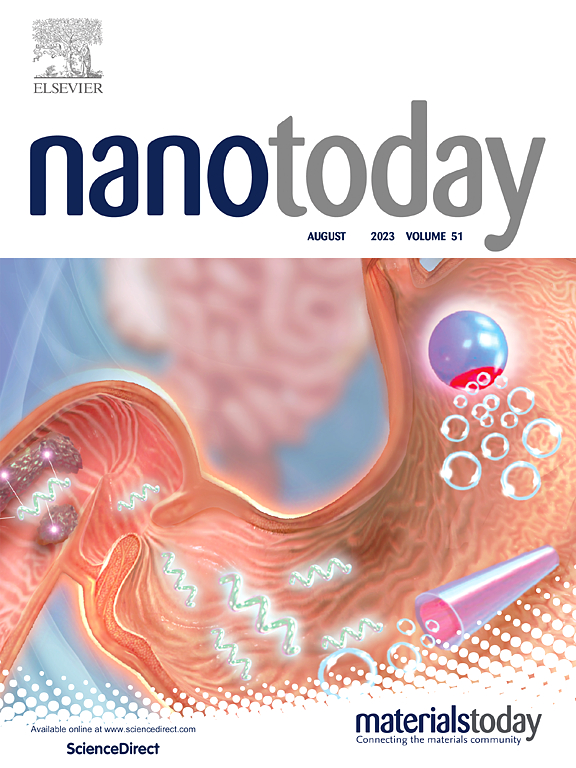基于人工智能负载分配的三维磁泳生物分析法,用于飞摩尔和免清洗分析物检测
IF 13.2
1区 材料科学
Q1 CHEMISTRY, MULTIDISCIPLINARY
引用次数: 0
摘要
要以飞摩尔级的灵敏度定量复杂样品中的低丰度生物标记物或痕量有害物质,需要耗费大量人力的孵育和多次洗涤步骤。在此,我们探索了一种基于人工智能(AI)辅助负载分配策略的轨迹/累积/颜色三维微流控磁泳免疫分析法(TAC-MMI),可在 30 分钟内免洗、飞摩尔级地检测血清样品中的白细胞介素-6 和食品样品中的氯霉素。固定在磁性纳米颗粒(MNPs)和聚苯乙烯微球-辣根过氧化物酶(PM-HRP)共轭物上的目标物和生物识别分子(抗原和抗体)之间的生物识别诱导了不同磁性含量的 MNP-目标物-PM-HRP 免疫复合物,目标物的浓度通过微流控芯片内的线性微管阵列的磁导力转化为空间可视化信息。可视化信息可通过 HRP 催化的颜色反应得到增强。每个微管中可吸入颗粒物的轨迹-累积-颜色都被精确地赋予了意义,并通过人工智能进行生物分析识别。TAC-MMI 具有高灵敏度(fM 级)、快速(30 分钟)和使用方便等特点,无需清洗步骤。与传统的一维传感策略相比,基于负载分配的三维传感策略将灵敏度提高了 96 倍以上。与化学发光免疫测定(CLIA)相比,TAC-MMI 的灵敏度提高了 15 倍,所需的时间仅为 CLIA 的三分之一,这表明磁浮生物测定诊断技术前景广阔。本文章由计算机程序翻译,如有差异,请以英文原文为准。
Three-dimensional magnetophoretic bioassay based on artificial intelligence-mediated load assignment for the femtomolar and washing-free detection of analytes
The quantification of low-abundance biomarkers or trace harmful substances in complex samples at femtomolar-level sensitivity requires labor-intensive incubation and multiwashing steps. Herein, we explore a trajectory/accumulation/color three-dimensional microfluidic magnetophoresis immunoassay (TAC-MMI) based on an artificial intelligence (AI)-assisted load assignment strategy, enabling washing-free and femtomolar detection of interleukin-6 in serum samples and chloramphenicol in food samples within 30 min. The biorecognition between targets and biometric molecules (antigens and antibodies) immobilized on magnetic nanoparticles (MNPs) and polystyrene microsphere-horseradish peroxidase (PM-HRP) conjugate induces MNP-target-PM-HRP immunocomplexes with different magnetic contents, where the concentration of targets is transformed into spatial visualization information through magnetophoretic force using a linear microtube array within a microfluidic chip. The visualization information can be enhanced by the HRP-catalyzed color reaction. Trajectory-accumulation-color of PM in each microtube is precisely assigned significance and identified via AI for bioanalysis. TAC-MMI demonstrates high sensitivity (fM level), rapidity (30 min), and ease of use without washing steps. The three-dimensional sensing strategy based on load-assignment improved sensitivity by more than 96-fold compared with the traditional one-dimensional sensing strategy. Compared to chemiluminescence immunoassay (CLIA), TAC-MMI achieved 15-fold improvement in sensitivity in only one-third of the time required for CLIA, suggesting a promising magnetophoretic bioassay for diagnostic technology.
求助全文
通过发布文献求助,成功后即可免费获取论文全文。
去求助
来源期刊

Nano Today
工程技术-材料科学:综合
CiteScore
21.50
自引率
3.40%
发文量
305
审稿时长
40 days
期刊介绍:
Nano Today is a journal dedicated to publishing influential and innovative work in the field of nanoscience and technology. It covers a wide range of subject areas including biomaterials, materials chemistry, materials science, chemistry, bioengineering, biochemistry, genetics and molecular biology, engineering, and nanotechnology. The journal considers articles that inform readers about the latest research, breakthroughs, and topical issues in these fields. It provides comprehensive coverage through a mixture of peer-reviewed articles, research news, and information on key developments. Nano Today is abstracted and indexed in Science Citation Index, Ei Compendex, Embase, Scopus, and INSPEC.
 求助内容:
求助内容: 应助结果提醒方式:
应助结果提醒方式:


